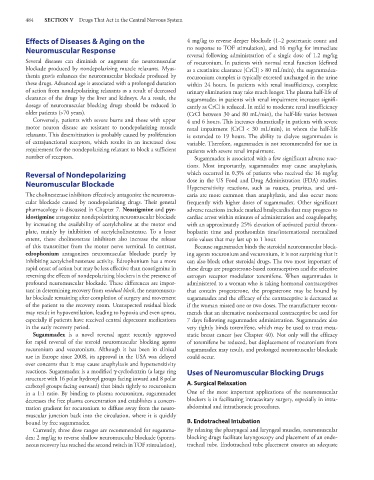Page 498 - Basic _ Clinical Pharmacology ( PDFDrive )
P. 498
484 SECTION V Drugs That Act in the Central Nervous System
Effects of Diseases & Aging on the 4 mg/kg to reverse deeper blockade (1–2 posttetanic count and
Neuromuscular Response no response to TOF stimulation), and 16 mg/kg for immediate
reversal following administration of a single dose of 1.2 mg/kg
Several diseases can diminish or augment the neuromuscular of rocuronium. In patients with normal renal function (defined
blockade produced by nondepolarizing muscle relaxants. Myas- as a creatinine clearance [CrCl] > 80 mL/min), the sugammadex-
thenia gravis enhances the neuromuscular blockade produced by rocuronium complex is typically excreted unchanged in the urine
these drugs. Advanced age is associated with a prolonged duration within 24 hours. In patients with renal insufficiency, complete
of action from nondepolarizing relaxants as a result of decreased urinary elimination may take much longer. The plasma half-life of
clearance of the drugs by the liver and kidneys. As a result, the sugammadex in patients with renal impairment increases signifi-
dosage of neuromuscular blocking drugs should be reduced in cantly as CrCl is reduced. In mild to moderate renal insufficiency
older patients (>70 years). (CrCl between 30 and 80 mL/min), the half-life varies between
Conversely, patients with severe burns and those with upper 4 and 6 hours. This increases dramatically in patients with severe
motor neuron disease are resistant to nondepolarizing muscle renal impairment (CrCl < 30 mL/min), in whom the half-life
relaxants. This desensitization is probably caused by proliferation is extended to 19 hours. The ability to dialyze sugammadex is
of extrajunctional receptors, which results in an increased dose variable. Therefore, sugammadex is not recommended for use in
requirement for the nondepolarizing relaxant to block a sufficient patients with severe renal impairment.
number of receptors. Sugammadex is associated with a few significant adverse reac-
tions. Most importantly, sugammadex may cause anaphylaxis,
Reversal of Nondepolarizing which occurred in 0.3% of patients who received the 16 mg/kg
Neuromuscular Blockade dose in the US Food and Drug Administration (FDA) studies.
Hypersensitivity reactions, such as nausea, pruritus, and urti-
The cholinesterase inhibitors effectively antagonize the neuromus- caria are more common than anaphylaxis, and also occur more
cular blockade caused by nondepolarizing drugs. Their general frequently with higher doses of sugammadex. Other significant
pharmacology is discussed in Chapter 7. Neostigmine and pyr- adverse reactions include marked bradycardia that may progress to
idostigmine antagonize nondepolarizing neuromuscular blockade cardiac arrest within minutes of administration and coagulopathy,
by increasing the availability of acetylcholine at the motor end with an approximately 25% elevation of activated partial throm-
plate, mainly by inhibition of acetylcholinesterase. To a lesser boplastin time and prothrombin time/international normalized
extent, these cholinesterase inhibitors also increase the release ratio values that may last up to 1 hour.
of this transmitter from the motor nerve terminal. In contrast, Because sugammadex binds the steroidal neuromuscular block-
edrophonium antagonizes neuromuscular blockade purely by ing agents rocuronium and vecuronium, it is not surprising that it
inhibiting acetylcholinesterase activity. Edrophonium has a more can also block other steroidal drugs. The two most important of
rapid onset of action but may be less effective than neostigmine in these drugs are progesterone-based contraceptives and the selective
reversing the effects of nondepolarizing blockers in the presence of estrogen receptor modulator toremifene. When sugammadex is
profound neuromuscular blockade. These differences are impor- administered to a woman who is taking hormonal contraceptives
tant in determining recovery from residual block, the neuromuscu- that contain progesterone, the progesterone may be bound by
lar blockade remaining after completion of surgery and movement sugammadex and the efficacy of the contraceptive is decreased as
of the patient to the recovery room. Unsuspected residual block if the woman missed one or two doses. The manufacturer recom-
may result in hypoventilation, leading to hypoxia and even apnea, mends that an alternative nonhormonal contraceptive be used for
especially if patients have received central depressant medications 7 days following sugammadex administration. Sugammadex also
in the early recovery period. very tightly binds toremifene, which may be used to treat meta-
Sugammadex is a novel reversal agent recently approved static breast cancer (see Chapter 40). Not only will the efficacy
for rapid reversal of the steroid neuromuscular blocking agents of toremifene be reduced, but displacement of rocuronium from
rocuronium and vecuronium. Although it has been in clinical sugammadex may result, and prolonged neuromuscular blockade
use in Europe since 2008, its approval in the USA was delayed could occur.
over concerns that it may cause anaphylaxis and hypersensitivity
reactions. Sugammadex is a modified γ-cyclodextrin (a large ring Uses of Neuromuscular Blocking Drugs
structure with 16 polar hydroxyl groups facing inward and 8 polar
carboxyl groups facing outward) that binds tightly to rocuronium A. Surgical Relaxation
in a 1:1 ratio. By binding to plasma rocuronium, sugammadex One of the most important applications of the neuromuscular
decreases the free plasma concentration and establishes a concen- blockers is in facilitating intracavitary surgery, especially in intra-
tration gradient for rocuronium to diffuse away from the neuro- abdominal and intrathoracic procedures.
muscular junction back into the circulation, where it is quickly
bound by free sugammadex. B. Endotracheal Intubation
Currently, three dose ranges are recommended for sugamma- By relaxing the pharyngeal and laryngeal muscles, neuromuscular
dex: 2 mg/kg to reverse shallow neuromuscular blockade (sponta- blocking drugs facilitate laryngoscopy and placement of an endo-
neous recovery has reached the second twitch in TOF stimulation), tracheal tube. Endotracheal tube placement ensures an adequate

